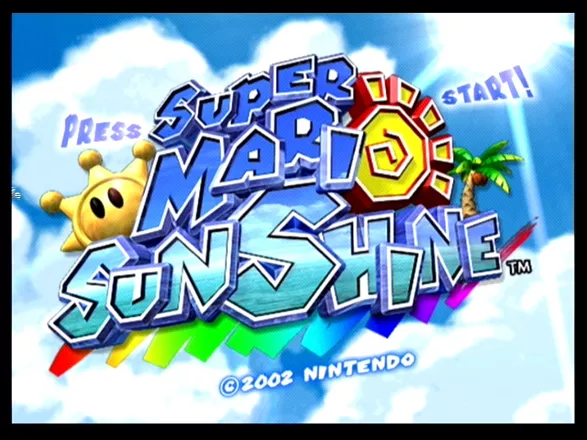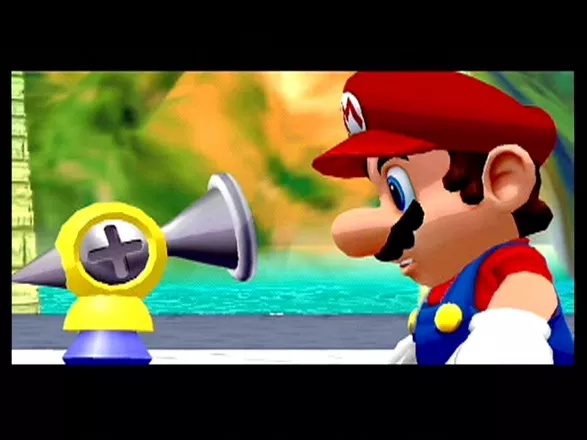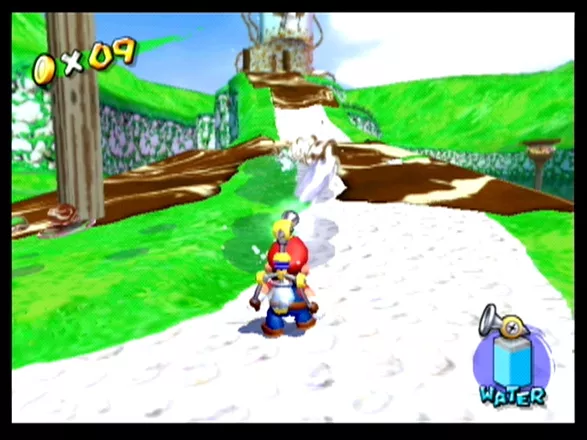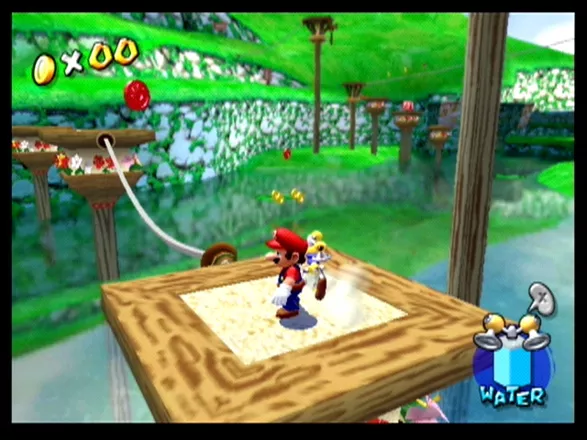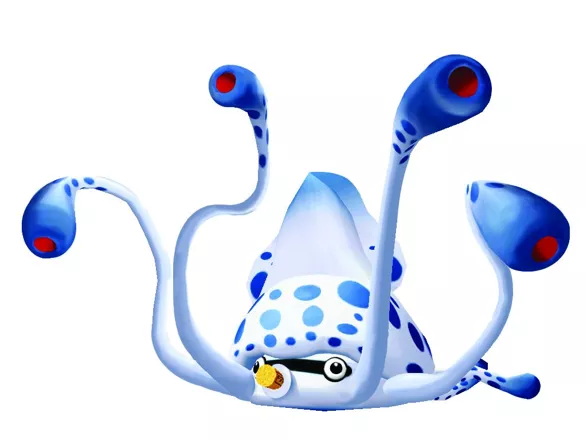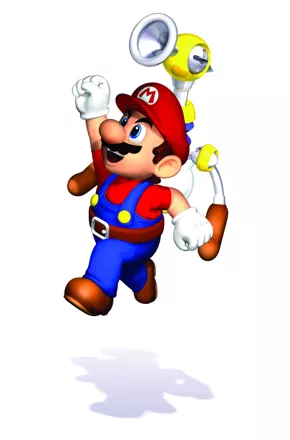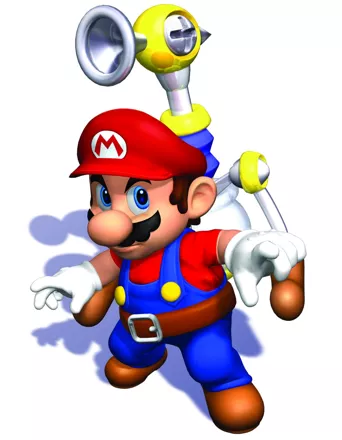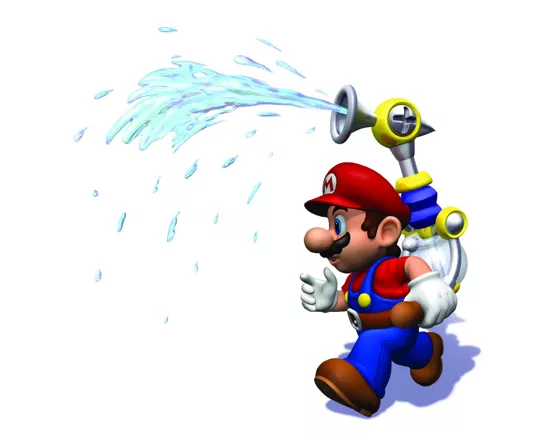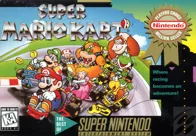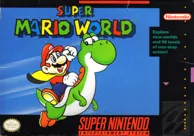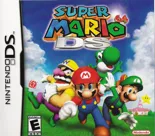Description official descriptions
Mario, Princess Peach, Toadsworth, and Toad have come to Isle Delfino for some relaxation. Upon arrival, however, they discover the island has been polluted causing its energy source, the Shine Sprites, to disappear. The culprit is similar in appearance to Mario, who is blamed for the mess, so the portly plumber is forced to clean up the island. Mario is given an invention called FLUDD (a backpack with several water nozzles) to help him clean up graffiti and mud and capture the real villain. Gameplay features a combination of action and puzzle solving, with numerous stages and multiple episodes to each stage, and plenty of hidden secrets and surprises.
Spellings
- スーパーマリオサンシャイン - Japanese spelling
- 슈퍼 마리오 썬샤인 - Korean spelling
Groups +
Screenshots
Promos
Videos
See any errors or missing info for this game?
You can submit a correction, contribute trivia, add to a game group, add a related site or alternate title.
Credits (GameCube version)
100 People (76 developers, 24 thanks) · View all
| Executive Producer | |
| Producers | |
| Directors | |
| Map Director | |
| Assistant Directors | |
| Character Design | |
| Map Design | |
| Map Object Design | |
| Screen Design | |
| [ full credits ] | |
Reviews
Critics
Average score: 87% (based on 69 ratings)
Players
Average score: 3.9 out of 5 (based on 149 ratings with 8 reviews)
The Good
Where to start...It's got great colors and details,and the graffiti around the island has great coloring. I absolutely adore FLUDD, as a tool and a character. Also the enemies in this game are creative and I like how there are many that seem to only be native to Island Delfino. Lastly I feel like I can just explore if I want to and play around, go spray people, climb things, and overall have fun exploring.
The Bad
Some of the shines seem rather tedious and hard to get. I have mixed feelings about having to fight one boss three times, and another boss about four or five times.
The Bottom Line
Super Mario Sunshine is a great,creative, and overall fun game. Mario faces things he's never faced before, and even gets a great new friend\tool named F.L.U.D.D. I think it's the best Mario game and you should play it.
GameCube · by Kiara Cunningham (13) · 2015
The Good
The movement is tight, the locales interesting to explore, and it looks gorgeous too. The blue coins give the player an extra incentive to explore every corner of its levels, each of which is carefully crafted to be a playground where the player can have fun with the mechanics.
The Bad
Some levels in this game are just too hard. Pachinko comes to mind. The lilypad level is also diabolical.
The Bottom Line
This game improves on its predecessor in every way. Mario 64 established the 3D platformer formula and this game perfected it.
GameCube · by Tedder (1) · 2025
The Good
Super Mario Sunshine was released in 2002 to pretty much universal acclaim. IGN gave it a 9.5 and I'm fairly sure Eurogamer was ready with a 10/10 for this bad boy.
It's an interesting game because it incorporates storytelling devices that Shigeru Miyamoto tends to avoid in his other games. The most notable new feature is voice acting, however I can get to that later.
In Super Mario Sunshine Mario is off on a vacation with Princess Peach in a hilariously camp giant pink jet. They land on Isle Delfino (which is probably like the Mushroom Kingdom's Florida) and right away Mario is accused of vandalism. It seems some sort of shadowy imposter has been running around grafitto-tagging the beautiful buildings and natural environment of Isle Delfino and standing accused of a crime he didn't commit Mario is forced to pay penance by cleaning the entire island. With a helpful talking water pack strapped to his back called FLUDD he travels around various locales...cleaning. It's more exciting than it sounds really, after all it's Mario.
Our portly plumber controls almost identically to his appearance on the Nintendo 64 save for a couple of new FLUDD specific moves and a new spinny, jumpy type thing that can be used to clean himself or get to higher places. The FLUDD pack is used to glide, rocket about and clean off the goop that is covering Isle Delfino. The pack also talks, meaning it is used as a defacto guide around the island and provides hints every now and then. I quite liked the addition of the FLUDD pack, the whole cleaning aspect of the game had the potential to be an outright bore but miraculously it's really quite fun and satisfying to clean away all of the mess and end up with a pristine beach or side walk. The FLUDD pack is also used to defeat enemies and as I mentioned before, is an aid while platforming. The platforming is quite weak in Sunshine, so the inclusion of the FLUDD makes potentially controller breaking portions of the game very bearable, until you are forced to go without the FLUDD pack. This brings me onto the new “secret” areas. These “secrets” aren't really very secret at all, they are always very obviously placed. The secret areas are FLUDD-less portions of the game that play like a more linear, back to basics platformer. You are tasked with going from A to B negotiating obstacles while trying not to fall into the void below. These secret areas range from really inventive and fun, to downright malicious.
The level design in Sunshine is very solid and interesting. The game shines (no pun intended) when Mario is tasked with simply going from A to B, practicing his platforming mastery while defeating enemies and collecting coins. There is a lot of this in the game, but not nearly enough. Level goals vary from racing to defeating a boss enemy to breaking into a spa to collect a shine sprite, the requisite collectable in the game.
The shine sprite's are supposed to power the island and without them...well it's not really clear what the big deal is with the shine sprites. The island isn't imploding or anything because they have all been scattered, it's more of a minor inconvenience really. Anyway, the point is, they function like the stars did in Super Mario 64. Your progress through the game isn't really governed by the amount of stars you collect though, it's mostly down to finishing up to episode 7 of each level. It's a nice new progression scheme, one I like. You still find yourself grinding those shine sprites though, the game is just that addictive.
Graphically this is one of the best looking Gamecube game's out there. The engine is super solid. I have not noticed the frame rate dip once while I have been playing and the vivid, almost pastel like textures and gorgeous environmental effects like heat haze are just superb. Mario animates fantastically and I especially like the awesome way he seems to demolecularize when he enters a level.
I'd like to note the approach towards the aesthetic elements of the secret area's as well. They seem to have this spherical texture that wraps around the void that the simplistic platforming elements are suspended in. They are very minimalist areas and I was very charmed by them.
The Bad
Super Mario Sunshine is a game of extreme's, either it's being extremely good or extremely bad. I've never found myself just mildly frustrated by this game, either you can do something the first time or you constantly have to restart.
The problem isn't the fundamental dynamics the game relies upon. I already said how solid these are. The problem is the lazy, ill programmed and downright malicious camera system. The camera is an insufferable prick, pardon my french.
I cannot tell you the amount of occasions it has totally screwed me over, doing ridiculous things that really, it shouldn't be doing.
It's the main reason the secrets range from awfully fantastic to just plain awful. If the secret is a relatively simple one with a course that doesn't wind too much the camera will do an adequate job of keeping up. However if the secret has multiple levels, snaking turns or giant moving things the camera will totally ruin your day.
The main problem is that it is lazy. It takes forever to circle around to an adequate view of Mario meaning you'll constantly have to manually manipulate it to get a view of the action that won't get you killed. Having to concentrate on executing difficult jumps while manipulating this piss poor camera is a pain in the ass and ends up causing way too much undue frustration.
There are even indicators that the team knew the camera sucked and without any extra development time to spare on it applied a quick fix. When Mario heads behind something a silhouette will appear, with little question marks indicating enemies and objects. If the camera naturally snapped to a decent three quarter perspective of Mario under normal circumstances there would have been no need for this.
Also, when being launched upwards, instead of fixing itself on Mario and zooming out to give you an indication of where you are heading the camera stays where it is and points directly up at Mario meaning you're basically flying blind. It's atrocious.
Like I said, if your current activities are relatively simple there probably won't be a problem but when things heat up, the platforming because more demanding and the environments become more complicated, you're going to notice how utterly broken the camera system is.
Another thing I wanted to mention was how monotonous the whole tropical setting for the game becomes. It's always sunny and there is very little variation in the general aesthetics for each area. I get that the team was trying to convey the illusion of this cohesive environment but the variety in artistic direction suffers because of this and frankly it becomes a little tiresome. The inhabitants of Isle Delfino are also pretty much all identical with a bit of pallet swapping going on here and there. This goes for the music as well. Apart from a couple of awesome tunes (which happen to be remixes of music from better Mario games) a lot of the music in Sunshine is just an endless variation on this one theme with a different crappy instrument. The only regular level theme worth mentioning is Noki Bay, and even that isn't worth downloading. The soundtrack is forgettable and lackluster. Frankly, I expect better from Kenji Kondo.
I just briefly want to talk about the story for a moment. I admire Shigeru Miyamoto for finally including something of a more meaty narrative to power the game along, but it's just not very good. It's like very little effort was put into it, we know who the antagonist is going to be, it's not like the game was going to introduce any new major characters. Therefore it stands to question whether the inclusion of such a weak, poorly acted narrative was all that necessary. Peach still ends up getting kidnapped, the antagonist still ends up being Bowser, so why convolute it beyond an opening cinema to establish what is going on?.
The Bottom Line
I got totally addicted to Super Mario Sunshine and kept playing it for hours despite its flaws. There is a lot to like about the game and the core platforming game play is incredibly solid and satisfying. The game is a blast when the challenge is to simply negotiate a platform challenge while collecting coins and grabbing that shine sprite at the end. The variation in level goals was a treat, but ultimately I just wanted to platform, and I wish there was more of it in the game.
Sunshine is beautiful, with one of the most solid graphics engines I have ever seen on the Gamecube and the FLUDD pack, which could have been nothing more than a forgettable gimmick, ends up becoming a really cool platforming aide.
The camera system however ends up taking the greatest aspect of the game and smashing it into tiny pieces on the ground. The camera is a total prick that constantly sabotages your efforts at negotiating the tricky secret areas by not following Mario, following him too rigidly or becoming stuck on things. It wasn't taught to negotiate simple obstacles, stick to Mario properly or zoom out to give the player an adequate view in the appropriate circumstances. I just don't understand the almost universal glowing praise when this piss poor system was implemented 6 years after Super Mario 64 which was supposed to have kicked off this dynamic camera revolution.
While I loved Super Mario Sunshine the woeful camera, monotonous artistic direction, lack of real platforming, weak soundtrack and flimsy narrative keep it from being a truly great game.
GameCube · by AkibaTechno (238) · 2010
Trivia
1001 Video Games
Super Mario Sunshine appears in the book 1001 Video Games You Must Play Before You Die by General Editor Tony Mott.
Bugs
There is a major glitch in the game that allows you to access a sub world, sometimes called the "Blue Hell". The game physics are dropped down (meaning, for example, you can move around normally underwater, but if you jump it will revert to normal) and you can access many areas with little or no effort, particularly the Yoshi fruit boats.
Japanese version
In the Japanese version of Super Mario Sunshine, "Isle Delfino" is known as "Dolphic Island". When a player retrieves a Shine Sprite, the "message" says "Shine Get!" instead of the English "Shine!" Also, despite being developed in Japan, the Japanese version is all in English with Japanese subtitles.
References
- This game is set on a tropical island named Isle Delfino. "Delfino" is Italian for "Dolphin", which was Gamecube's prototype's name. Also, there are some words written in Italian around the game, like "Benvenuto" ("welcome"), etc.
- There's a reference to the Beatles in this game. There is a yellow submarine on the Ricco Harbor stage.
- In the attic of the Hotel Delfino, the janitor complains about the ghosts, wishing someone would come and "suck them up in a vacuum cleaner". This is a reference to another Gamecube title, Luigi's Mansion, where Luigi did indeed suck up ghosts in a vacuum cleaner.
- When you first find FLUDD, look in the lower left corner to view scenes from previous Mario games, including Super Mario Bros., Super Mario World, and Super Mario 64.
Awards
- 4Players
- 2002 – Best GameCube Game of the Year (Readers' Vote)
- 2002– Best GameCube Dexterity Game of the Year
- 2002 – Best GameCube Dexterity Game of the Year (Readers' Vote)
Information also contributed by Ben Miller, gamewarrior, MegaMegaMan, and Tiago Jacques
Analytics
Related Sites +
-
Super Mario Sunshine
Nintendo's Official Site.
Identifiers +
Contribute
Are you familiar with this game? Help document and preserve this entry in video game history! If your contribution is approved, you will earn points and be credited as a contributor.
Contributors to this Entry
Game added by Servo.
Additional contributors: JPaterson, okJigu, Guy Chapman, Alaka, gamewarrior, Patrick Bregger, Rik Hideto, FatherJack.
Game added August 28, 2002. Last modified March 23, 2025.




